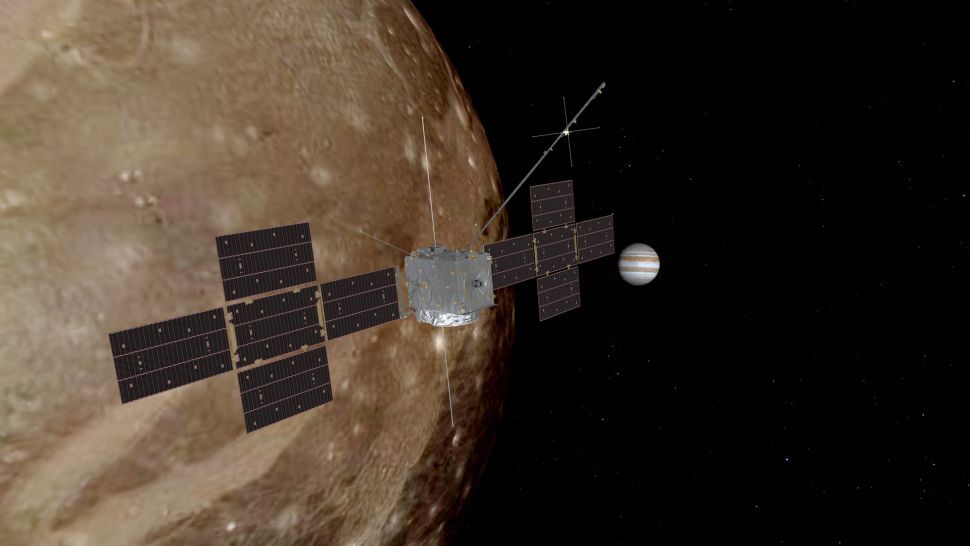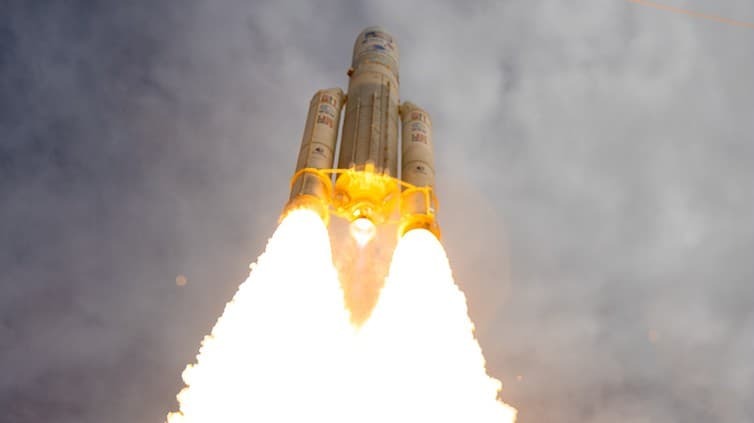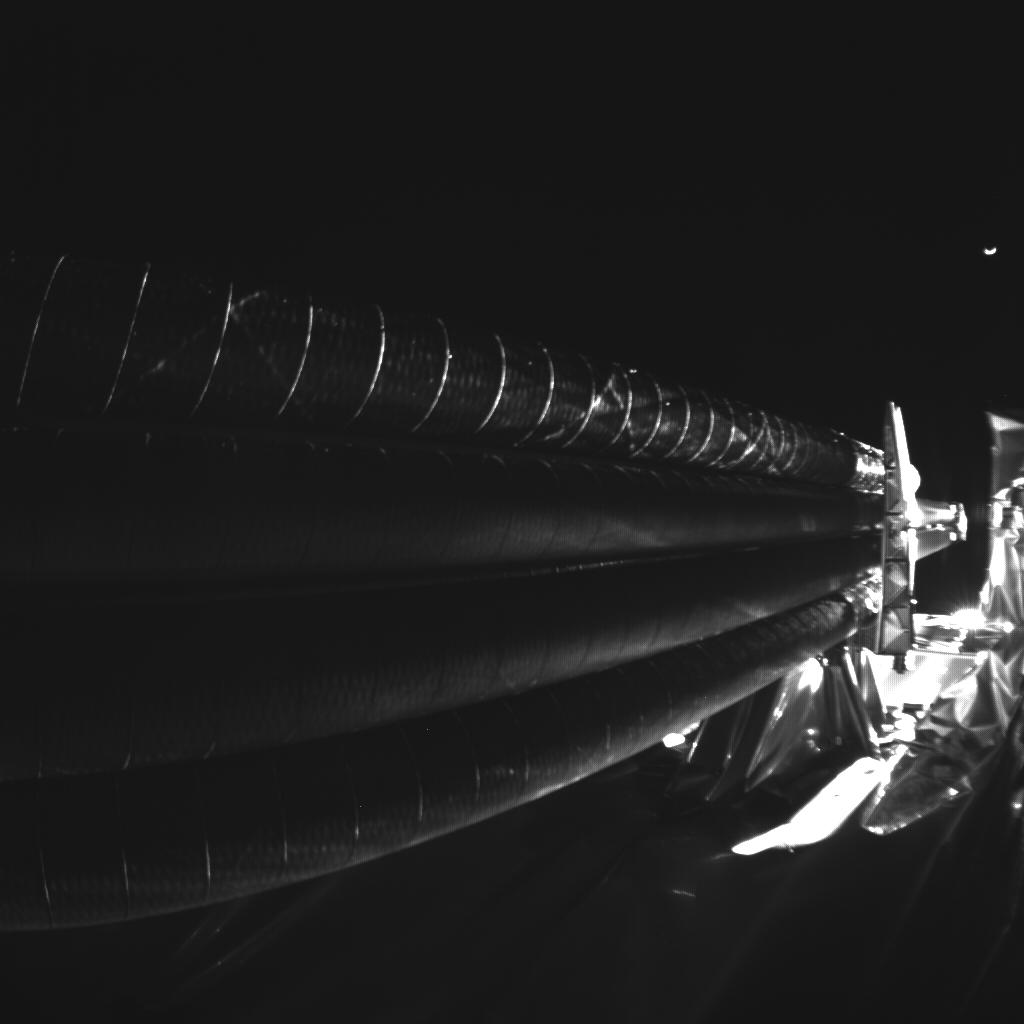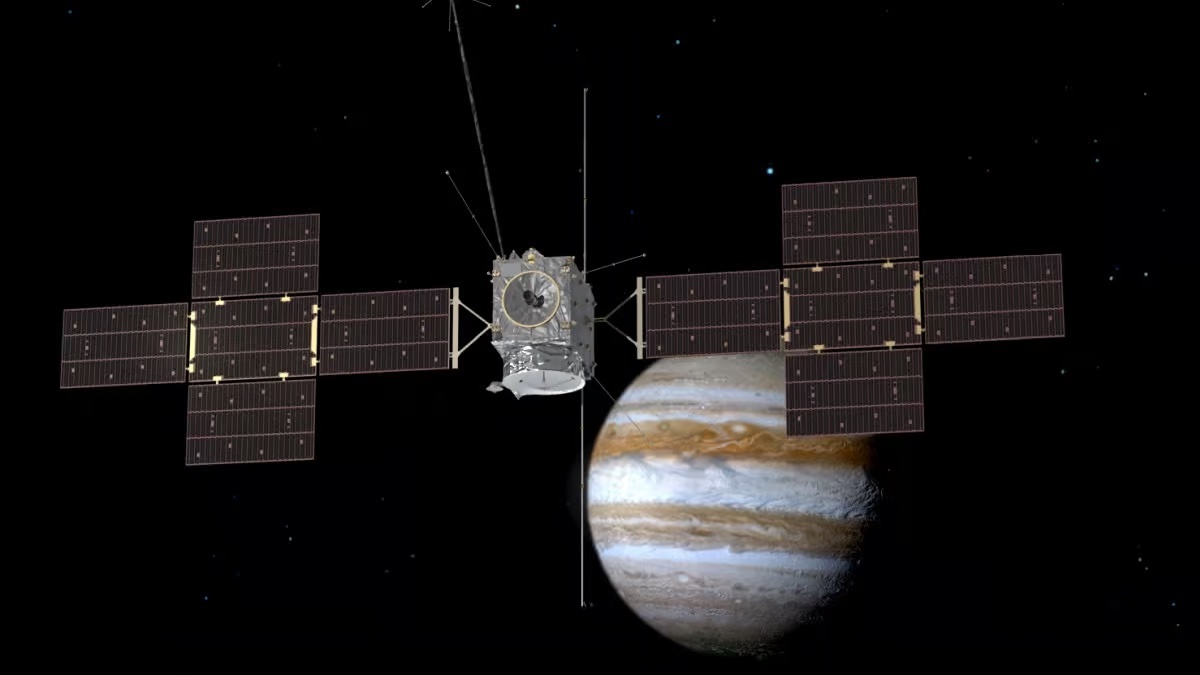17.04.2023
What's next for Europe's JUICE mission? Here's what to expect on its long journey to Jupiter
JUICE's journey to Jupiter includes fly-bys of Venus and Earth.

The European Space Agency's (ESA) flagship mission to Jupiter and its icy moons is underway.
But after the successful launch of the JUICE (Jupiter Icy Moons Explorer) spacecraft, what's next for the 1.6 billion euro ($1.77 billion) mission to Jupiter?
After blasting off into the sky above Europe's spaceport in French Guiana, JUICE now embarks on an eight-year journey that will see it perform fly-bys of Venusand Earth to gain gravity assists that will accelerate it to an encounter with Jupiter in 2031.
But the long journey does not mean that mission scientists will get to put their feet up for eight years. In fact, their work is just beginning.
"It would be nice to forget about it for eight years, but we'll be kept pretty busy planning and replanning," said Randy Gladstone, of the South-west Research Institute in San Antonio, Texas, in an interview with Space.com. Gladstone is the Principal Investigator on JUICE's Ultraviolet Spectrograph (UVS), which is one of NASA's contributions to the JUICE project.
JUICE will return to Earth in August 2024 for a fly-by and gravity assist that will then send it in-system to a rendezvous and another gravity assist at Venus in August 2025. Two more gravity assists with Earth will take place in September 2026 and January 2029, the latter one taking advantage of the dance of the planets and sending JUICE on its way at high speed towards Jupiter.
While all this is happening, mission scientists have to learn about how the spacecraft and their instruments work. Although the instruments have been checked out in the laboratories where they were built on Earth, their performance for real in space can create complications.
Learning how the instruments work will be "the first thing to do," said Gladstone. On the spacecraft, the various instruments may begin to impact each other. For example, one instrument next to another might warm up more than its neighbor prefers, affecting the other instruments' functionality, while in the micro-gravity of space the whole spacecraft relaxes leading to small changes in alignment.
To calibrate everything, the instrument teams will use carefully chosen target stars that have very stable and well-known properties. In particular, Gladstone's team will compare the known spectra of the stars with what UVS observes, proceeding to fine-tune the instrument until the observations match the spectra on file.
Some of the calibration of the various instruments will also take place during the fly-bys of Earth and Venus, although testing is limited within two astronomical units of the sun (twice the distance of Earth from the sun, a little bit beyond Mars' orbit). While in the inner solar system, JUICE will shield its instruments from the sun by using its antenna dish like a parasol. Were the instruments exposed to the bright sun by accident, they could be damaged beyond repair, and so pointing the instruments while close to the sun is prohibited.
"At Venus [the sun] is too hot for us to even operate, but the Earth fly-bys later will be very valuable for calibration and getting ready for Jupiter," said Gladstone.
After its final fly-by of Earth, JUICE will be slingshot on a trajectory towards Jupiter. By this time it will have been overtaken by NASA's Europa Clippermission, which launches in October 2024 and arrives at Jupiter in April 2030, one year ahead of JUICE.
JUICE won't simply be a bystander while Europa Clipper is in action at Jupiter, where it will possibly join NASA's Juno spacecraft that has been in orbit around Jupiter since 2016, assuming it is still functioning. JUICE will be able to provide early warning for both Europa Clipper and Juno if there is a powerful and potentially harmful solar flare directed at Jupiter.
A year before Jupiter orbit insertion (JOI), "we'll ramp up the team to start making observations," said Gladstone. "They won't all be of Jupiter, but they'll be similar to what we will be doing at Jupiter, so we'll spend a lot of time practicing with the instruments, and planning. There's a lot of stuff we can do, but the planning is the big thing."
Coordinating which instruments will be doing what and when during the 35 fly-bys of three of Jupiter's moons (two fly-bys of Europa, 12 of Ganymede and 21 of Callisto) will require much negotiation between the various instrument teams as well as those responsible for the spacecraft's fuel and power supplies.
"We're all pretty agreeable, but it's still a lot of work to sort out what we're going to do second-by-second for the five years that we're there at Jupiter," said Gladstone. "But we'll figure out the best way to get the best science for each fly-by."
From Gladstone's point of view, the UVS is concerned with mapping ultraviolet emissions. It does this by passing ultraviolet light through a slit, after which it hits a diffraction grating that spreads out the light into its various ultraviolet wavelengths — a spectrum.
"Most matter interacts really strongly with ultraviolet light, and [UVS] is very sensitive to tiny amounts of gases, which is sort of what Jupiter's moons have for atmospheres," said Gladstone.
These tenuous atmospheres — referred to as 'exospheres' — cling to the moons, sputtered off their surface by micrometeorite impacts. They can be observed either directly through their ultraviolet emissions when atoms and molecules are excited by collisions with charged particles that fizz around Jupiter's powerful magnetosphere, or indirectly by watching a moon's exosphere absorb some of the light of a star or the sun during an occultation. The wavelength absorbed gives away the identity of the atom or molecule doing the absorbing.
Meanwhile, ultraviolet sunlight reflected by the moons can give away details about their surfaces.
"UVS will tell us a lot about the surface composition and structure," said Gladstone. "We know the surfaces are icy, but there's a lot of other materials down there besides the ice."
UVS will also be able to study the ultraviolet auroras that flicker around the magnetic poles of Jupiter. These auroras have previously been observed by the Hubble Space Telescope, the James Webb Space Telescope and by Juno. However, Hubble and James Webb cannot keep a constant eye on the auroras, and Juno spins on its axis to maintain its stability, meaning that its instruments cannot linger on the auroras long enough to see the fainter ones.
"With JUICE we'll be able to look at those fainter auroras too," said Gladstone.
The planning and practicing that will take place over the next eight years will set the stage for the epic of discovery that will follow, as JUICE provides an unprecedented tour of the Jovian system. Gladstone can't wait to get started.
"There's a lot of great stuff to learn," he said. "With all the variety JUICE is going to see and do, it's going to be exciting once it gets there."
Quelle: SC
----
Update: 18.04.2023
.
First pictures from JUICE spacecraft released after launch
Jupiter explorer sets off for 12-year adventure.

The European Space Agency’s JUICE mission has successfully launched, putting into action a decade-long mission to chart three of Jupiter’s largest moons.
Australia’s New Norcia ground station, about 132km north of Perth, acquired the signal of the Jupiter Icy Moons Explorer on Friday evening local time as it began unfurling its 27m long solar arrays.
It will continue deploying its operational antennas and instrument booms over the first 17 days of its mission. However this only marks a tiny fraction of the craft’s operational time. JUICE will spend eight years performing a series of gravity-assisted flybys around Earth, the Moon and Venus to slingshot itself towards Jupiter.
Upon arrival at the gas giant in 2031, JUICE will begin charting Jupiter’s three icy moons – Ganymede, Callisto and Europa – to find whether they support liquid water beneath their surfaces.
The mission will culminate in 2035 with a gravity-assisted collision into the surface of Ganymede.
First pictures
ESA has released the first images of JUICE’s deployment, including rear-view images of the craft breaking free of Earth, and the rotation of its solar arrays.



The solar arrays power JUICE’s essential instruments which will be checked by ESA mission controllers over the next three months as the craft cruises through our solar neighbourhood ahead of its first Earth-Moon flyby in August 2024.
“To fly such a complex path from such an enormous distance – and vitally, to get Juice’s valuable data home to Earth – will require precise navigation techniques, reliant on ESA’s deep space antennas in Spain, Argentina and Australia, all controlled remotely from ESOC,” says the JUICE’s spacecraft operations manager, Ignacio Tanco.
Quelle: Cosmos
----
Update: 30.04.2023
.
Europe's JUICE Jupiter probe has an antenna glitch in deep space
Engineers "have lots of ideas up their sleeves" to fix the issue, the European Space Agency says.

Europe's flagship Jupiter mission is struggling to unfurl an antenna in deep space.
The Jupiter Icy Moons Explorer or JUICE spacecraft has a stuck antenna on one of its instruments, European Space Agency (ESA) officials reported Friday (April 28). The instrument is designed to penetrate the icy surface of Jupiter moons using radar, to seek signs of habitable conditions for life in the waters beneath.
"A matter of millimeters could make the difference to set the rest of the radar free," ESA officials wrote in an update(opens in new tab). Teams working on the partially deployed antenna "have lots of ideas up their sleeves" to free up the jam, they added.

The stuck antenna aboard JUICE's Radar for Icy Moons Exploration flaps about in an animation based on imagery obtained between April 17 and 21, 2023. (Image credit: ESA/Juice/JMC, CC BY-SA 3.0 IGO)
The $1.1 billion (870 million euros) JUICE launched on April 14 for an expected arrival at Jupiter's system in July 2031, where it will spend years flying around the icy Jupiter moons and learning more about their potentially life-friendly environments.
While 10 of the 11 spacecraft instruments are working fine so far, the spacecraft's Radar for Icy Moons Exploration (RIME) antenna is jammed in its mounting bracket. Engineers suspect a tiny stuck pin is holding it in place.
"Various options are still available to nudge the important instrument out of its current position," ESA officials wrote. "The next steps to fully deploy the antenna include an engine burn to shake the spacecraft a little, followed by a series of rotations that will turn JUICE, warming up the mount and radar, which are currently in the cold shadows."
Commissioning, or the first steps of getting a spacecraft ready for its mission, is ongoing for about the next two months. ESA officials emphasized there is "plenty of time for teams to get to the bottom of the RIME deployment issue" in the time remaining.
Assuming the 52-foot (16-meter) antenna unjams, it will allow JUICE to see as far as 20 feet (9 meters) underneath Jupiter moons like Ganymede or Europa. Europa in particular has shown signs of spewing water into space, suggesting the ice has exposure to the outside environment.
This is not the first time a Jovian mission faced antenna issues. NASA's Galileo mission never was able to deploy its high-gain antenna properly ahead of visiting Jupiter and its icy moons between 1995 and 2003. The mission still sent data back home, but at a lower rate than designed for.
Quelle: SC
----
Update: 2.05.2023
.
Jupiter explorer hits first snag as agency considers “shaking” spacecraft

The European Space Agency’s JUICE spacecraft is continuing in its attempts to deploy its 16-metre-long radar antenna, as its decade-long journey to Jupiter gets underway.
JUICE – the Jupiter Icy Moons Explorer mission – is one of the ESA’s most complex projects to date. It will complete four gravity-assisted flybys of Earth and Venus to propel itself towards the solar system’s largest planet, where it will investigate conditions for life on its large moons Ganymede, Callisto and Europa.
After launching on April 14, the craft was scheduled to spend 17 days deploying its instrumentation, however its Radar for Icy Moons Explorer (RIME) antenna has reportedly failed to release.
RIME is to scan nine kilometres beneath the surface of Jupiter’s icy moons to understand their sub-surface geography. But it’s only partially deployed, and ESA thinks a small pin is blocking the antenna from being released.
If the radar fails to fully deploy, mission control in Darmstadt, Germany, might consider an engine burn to shake the spacecraft and dislodge the blockage.
Beyond this, a statement from ESA described the deployment of JUICE’s instruments as “otherwise performing excellently”.
The solar arrays which will be used to power the spacecraft’s systems, its 10-metre-long magnetometer have all successfully extended.
First pictures from the JUICE launch
JUICE will continue activating its systems over the next two months as it prepares its course outside of the Earth system. Its first Earth-Moon flyby is scheduled for August 2024, followed by a Venus flyby one year later, and Earth flybys in September 2026 and January 2029 to enable its arrival at Jupiter in July 2031.
Quelle: COSMOS
